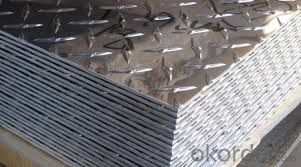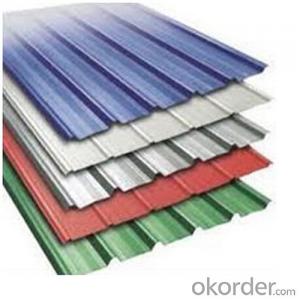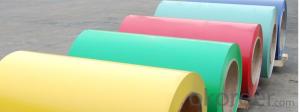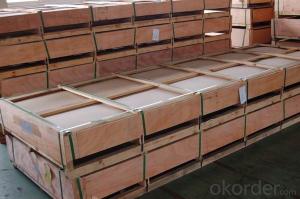ALUMINUM SHEET 1050PS LITHO SHEET STOCK CTP CTP CTOCK
- Loading Port:
- Ningbo
- Payment Terms:
- TT or LC
- Min Order Qty:
- 1 m.t.
- Supply Capability:
- 500000 m.t./month
OKorder Service Pledge
OKorder Financial Service
You Might Also Like
| 1XXX SERIES | 1050PS LITHO SHEET STOCK CTP CTP CTOCK | PRITING | H18 H16 | 0.14—0.27 |
| 1050 1060 1060 1070 1100 ANODIZING STOCK DEEP DRAW STOCK | COSMETIC CAP STOCK CAP STOCK ALUMINUM CIRCLE STOCK ACP STOCK TREAD PLATE SPECULAR SHEET CABINET SHEET LIGHTING COMPONENT STOCK CAPACITOR SHELL STOCK | ALL TEMPERS | 0.2—4.5 | |
| 1A99 1070 1235、1100 FOIL AND FOIL STOCK | CAPACITOR FOIL,HOUSEHOLD FOIL, FOIL STOCK | H14 H18 | 0.02—0.3 |
Aluminum Sheet (Plate) is availble in various alloys offering a range of weldability, corrosion resistance and machinability. High strength Aluminum Sheet, such as 7075, can be used in aerospace applications, and high corrosion resistance aluminum alloy sheets are commonly used in marine applications.



5052-H32 Aluminum Sheet - (ASTM B209, QQ-A-250/8) Superior corrosion resistance, good weldability, with excellent formability, makes 5052 Aluminum Sheet a common choice for chemical, marine or saltwater applications. 5052 Aluminum Sheet applications include: tanks, marine hardware, boat hulls, etc.
Non-magnetic, Brinell = 60, Tensile = 33,000, Yield = 28,000 (+/-)
6061-T651 Aluminum Sheet - (ASTM B209, QQ-A-250/11) Offers a combination of increased strength, corrosion resistance, and machinability making it the most widely used aluminum grade. 6061 Aluminum Sheet is heat treatable, resists cracking due to stress, is easy to weld and machine, but limited on formability. 6061 Aluminum Sheet is ideal for structural framing, base plates, gussetts, motorcycle & automotive parts, etc.
Non-magnetic, Brinell = 95, Tensile = 45,000, Yield = 40,000 (+/-)
- Q:What are the common sizes of aluminum sheets?
- The industry and application determine the common sizes of aluminum sheets. However, there are several standard sizes that are readily available. For general fabrication and construction, aluminum sheets typically range in thickness from 0.020 inches to 0.125 inches. These sheets are commonly found in sizes such as 4 feet by 8 feet, 4 feet by 10 feet, and 5 feet by 10 feet. In the automotive industry, aluminum sheets are frequently used for body panels and structural components. The sizes used in this sector can vary from 0.040 inches to 0.125 inches in thickness, with dimensions depending on the specific application or vehicle model. When it comes to aerospace applications, aluminum sheets are usually thinner and smaller. These sheets can be anywhere from 0.010 inches to 0.080 inches in thickness, with dimensions generally being smaller compared to other industries. It's important to note that while these sizes are common, custom sizes can also be manufactured to meet specific project requirements. Furthermore, specialized industries may have unique size requirements that differ from the general standards. Therefore, it is always advisable to consult suppliers or manufacturers to determine the most suitable size for a particular application.
- Q:What's the difference between 6061 aluminum plate, 7075 aluminium plate and 6063 aluminum plate?
- Simply put, 6061 and 6063 belong to the 6 series, 6061 hardness in 90HB 6063 in 80HB, suitable for brazing, surface oxidation treatment is better,
- Q:why is copper sheet but not aluminum sheet that becomes the negative pole after putting copper sheet and aluminum sheet connected with wire into concentrated nitric acid?
- According to metal reactivity series order table, aluminum has a better metallicity, but it will be passivated soon after contacting concentrated sulfuric acid, and won’t react again. But copper and concentrated sulfuric acid can react continually. So aluminum sheet becomes the positive pole after passivation.
- Q:Are aluminum sheets suitable for automotive heat shields?
- Certainly! Automotive heat shields can indeed utilize aluminum sheets. Aluminum is an exceptional option for heat management in automotive applications due to its lightweight nature and impressive conductivity. Its high melting point and excellent thermal conductivity properties allow it to efficiently absorb and disperse heat produced by the vehicle's engine, exhaust system, and other heat sources. Furthermore, aluminum sheets are easily moldable and can be crafted into diverse sizes and designs, making them adaptable for various automotive heat shield purposes. In summary, aluminum sheets offer an economical and effective means of safeguarding vulnerable components from heat-related harm within automotive systems.
- Q:Can aluminum sheet be used for heat shielding?
- Yes, aluminum sheet can be used for heat shielding due to its high thermal conductivity and ability to reflect and radiate heat effectively.
- Q:Can aluminum sheets be used for solar panel frames?
- Solar panel frames can indeed be made from aluminum. The reason behind aluminum's popularity as a material for solar panel frames lies in its remarkable strength-to-weight ratio, resistance to corrosion, and durability. These qualities render it suitable for the task of supporting and safeguarding solar panels, which are often installed in outdoor settings. By providing structural stability, aluminum frames guarantee the longevity of solar panels by shielding them from elements like wind, rain, and snow. Moreover, aluminum is readily recyclable, making it an environmentally-conscious option for solar panel frames.
- Q:What is the reflectivity of aluminum sheets?
- The reflectivity of aluminum sheets is quite high, typically ranging from 80% to 90%. This high reflectivity is due to the smooth surface and the unique properties of aluminum, which allow it to efficiently reflect light and other electromagnetic waves. This makes aluminum sheets commonly used in applications where high reflectivity is desired, such as in the construction of reflective surfaces, solar panels, and mirrors. Additionally, the reflectivity of aluminum can be further enhanced by applying a reflective coating or polishing the surface.
- Q:Aluminum knowledge. What is the model 3003 H24? What does H mean?
- H: work hardening state.(1) Hxx state:H1 * - hot rolling, Zhang Liqiang; H2 * - continuous casting and rolling, Zhang Liqiang, part of the toughening; H3 * - after stress treatment, stable performance; H4 * - after paint or coating; H x 2 - 25% x 4 - H hardness; hardness 50% processing; H * 6 - 75% hardness; H * 8 - 90 more than the hardness.(2) Hxxx state:H111: suitable for the final annealing, but also a proper amount of work hardening, but the degree of hardening is not as good as the H11 state of the product.H112: for hot forming products, the mechanical properties of the condition are specified.H116: made for magnesium content more than 4% 5 * * * alloy products. These products have specified mechanical properties and anti stripping corrosion resistance requirements.
- Q:Are aluminum sheets suitable for use in electrical applications?
- Yes, aluminum sheets are suitable for use in electrical applications. Aluminum has excellent conductivity and is lightweight, making it an ideal choice for electrical conductors, wiring, and components. Additionally, aluminum sheets offer good thermal conductivity and corrosion resistance, making them reliable and durable in various electrical environments.
- Q:How are aluminum sheets typically packaged for shipping?
- Aluminum sheets are typically packaged for shipping in a few different ways depending on the size and quantity of the sheets. One common method is to bundle the sheets together using metal or plastic strapping. The sheets are stacked on top of each other, with a layer of protective material such as foam or cardboard between each sheet to prevent scratching or damage. The bundle is then secured with strapping to keep the sheets tightly together during transit. For smaller quantities or smaller sheets, aluminum sheets may be packaged in boxes or crates. The sheets are carefully placed inside the box or crate, often separated by protective material to prevent rubbing or contact between the sheets. The box or crate is then sealed and labeled for shipping. In some cases, aluminum sheets may be packaged on pallets. Multiple sheets are stacked on a pallet, again with protective material between each sheet. The sheets are secured to the pallet using stretch wrap or shrink wrap to ensure stability during transportation. Regardless of the packaging method used, it is important to properly label the packages with relevant information such as the contents, weight, dimensions, and any special handling instructions. This helps to ensure that the aluminum sheets are handled and shipped correctly, reducing the risk of damage or loss during transit.
1. Manufacturer Overview |
|
|---|---|
| Location | |
| Year Established | |
| Annual Output Value | |
| Main Markets | |
| Company Certifications | |
2. Manufacturer Certificates |
|
|---|---|
| a) Certification Name | |
| Range | |
| Reference | |
| Validity Period | |
3. Manufacturer Capability |
|
|---|---|
| a)Trade Capacity | |
| Nearest Port | |
| Export Percentage | |
| No.of Employees in Trade Department | |
| Language Spoken: | |
| b)Factory Information | |
| Factory Size: | |
| No. of Production Lines | |
| Contract Manufacturing | |
| Product Price Range | |
Send your message to us
ALUMINUM SHEET 1050PS LITHO SHEET STOCK CTP CTP CTOCK
- Loading Port:
- Ningbo
- Payment Terms:
- TT or LC
- Min Order Qty:
- 1 m.t.
- Supply Capability:
- 500000 m.t./month
OKorder Service Pledge
OKorder Financial Service
Similar products
New products
Hot products
Hot Searches
Related keywords































